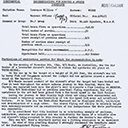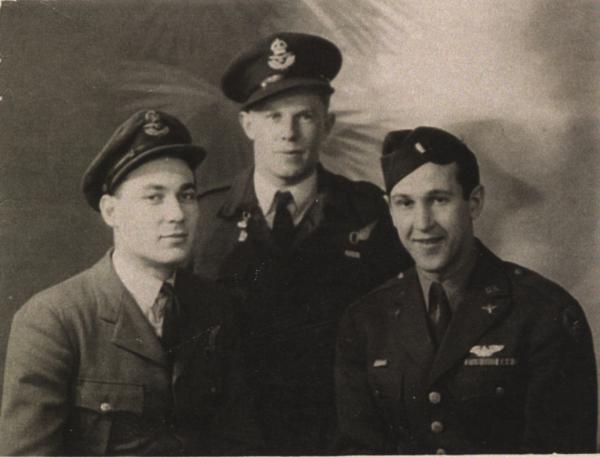
Posted 4th Jan 1944 to No 27 Operational Training Unit (OTU), Litchfield flying Wellington twin–engined bomber. Joined others as bomb aimer to form our crew.
As part of training we did a diversionary raid (listed in Bomber Command War Diaries), in support of Bomber Command raid on Frankfurt on 18th March, 1944 over the North sea to a point 02°10'E, almost to the European coast before turning back. On the flight we flew over, and was heavily bombarded by flak from naval ships. Fortunately escaped with a couple of small flak holes.
Final OTU flight 22nd March 1944 was a leaflet raid on Paris. We ran into a bunch of enemy fighters, several flares were dropped and an unsuccessful attack by an Me 109, his fire just missing the back of our plane. Heavy cloud assisted us to escape.
Posted to heavy conversion unit flying Halifaxes and final ten hours converting onto Lancasters. On 31st May, 1944 several targets raided by Bomber Command, we flew a diversionary (listed in Bomber Command War Diaries), to a point 02° 00' E and return.
Posted to Binbrook RAF Base - 460 squadron on 13th June 1944 with four other crews: 35 airmen, of which only eight of us were left by 9th November, 1944 when we flew our last raid over Wanne-Eikel.
View Laurie Woods WWII Raids in a larger map
The following is a list of the ranks that Laurie Woods atained in his career with the Royal Australian Air Force:
| Abbreviation | Rank name | Date atained |
|---|---|---|
| AC2 | Aircraftman Class II | 19/06/1942 (enlistment) |
| LAC | Leading Aircraftman | 12/09/1942 |
| SGT | Sergeant | 4/03/1943 |
| FLT SGT | Flight Sergeant | 8/09/1943 |
| WO | Warrant Officer | 4/09/1944 |
| PO | Pilot Officer | 8/10/1944 |
| FO | Flight Officer | 8/4/1945 |
| Date | Night (N)/ Day (D) | Raid | Target | Bomb Load (lbs) | |
|---|---|---|---|---|---|
| 1 | 30/06/1944 | N |
Raid railway marshalling yards | Vierzon Ville, France | 13,000 |
| 2 | 02/07/1944 | D |
Flying bomb launch installation | Oisemont, France | 13,000 |
| 3 | 04/07/1944 | N |
Railway marshalling yards | Orleans, France | 9,000 |
| 4 | 05/07/1944 | N |
Railway marshalling yards | Dijon, France | 9,500 |
| 5 | 07/07/1944 | D |
Military installation 2nd front | Caen, France | 13,000 |
| 6 | 12/07/1944 | N |
Railway marshalling yards | Tours, France | 12,500 |
| 7 | 14/07/1944 | N |
Railway marshalling yards | Revigny-sur-Ornain, France | 9,000 |
| 8 | 18/07/1944 | D |
Military installation 2nd front | Sannerville, Lower Normandy, France | 13,000 |
| 9 | 18/07/1944 | N |
Oil plant Ruhr Valley | Gelsenkirchen, Germany | 12,000 |
| 10 | 20/07/1944 | N |
Railway marshalling yards | Courtrai, Belgium | 13,000 |
| 11 | 25/07/1944 | D |
Flying bomb launch installation | Coquereaux, France | 13,000 |
| 12 | 09/08/1944 | D |
Flying bomb launch installation | Ferfay, France | 13,000 |
| 13 | 11/08/1944 | D |
Railway marshalling yards | Douai, France | 13,000 |
| 14 | 12/08/1944 | N |
Experiment bombing | Brunswick, Germany | 8,000 |
| 15 | 29/08/1944 | N |
Docks & city area (incendiaries only) | Stettin, Poland | 3,000 |
| 16 | 16/09/1944 | N |
Fighter aerodrome | Rheine, Germany | 9,000 |
| 17 | 20/09/1944 | D |
Long range gun sites | Sandgatte, France | 14,000 |
| 18 | 23/09/1944 | N |
Troop concentration | Neuss, Germany | 14,000 |
| 19 | 26/06/1944 | Framzelle, France | |||
| 25/09/1944 | D |
Gun sites 2nd front | Calais, France | 15,000 | |
| 26/09/1944 | D |
Guns & troops 2nd front | Cap Gris Nez, France | 15,000 | |
| 20 | 27/09/1944 | D |
Guns & troops 2nd front | Calais, France | 15,000 |
| 21 | 28/09/1944 | D |
Guns & troops 2nd front | Calais, France | 15,000 |
| 22 | 05/10/1944 | N |
City & rail station | Saarbrücken, Germany | 11,000 |
| 23 | 07/10/1944 | D |
Relief of "Red Devils" trapped in Arnhem Gap | Emmerich, Germany | 12,000 |
| 24 | 14/10/1944 | D |
Steelworks | Duisburg, Germany | 15,000 |
| 25 | 14/10/1944 | N |
Fires in the city | Duisburg, Germany | 15,000 |
| 26 | 19/10/1944 | N |
City & rail station | Stuttgart, Germany | 11,000 |
| 27 | 23/10/1944 | N |
City & rail station | Essen, Germany | 12,000 |
| 28 | 04/11/1944 | N |
City & rail station | Bochum, Germany | 13,000 |
| 29 | 06/11/1944 | D |
City & rail station | Gelsenkirchen, Germany | 11,000 |
| 30 | 09/11/1944 | D |
Munitions factory | Wanne-Eickel, Herne, Germany | 12,000 |
| Total | 376,000 | ||||
Lost parachute hatch taking off, permissible landing weight was 56,000 lbs. We circled till all Lancasters had taken off and then landed with all up weight of 64,800 lbs, which was then declared new permissible landing weight for Bomber Command, picked up our escape hatch and climbed on track to catch up. Mid–upper turret oil pressure pipe blew at 12,000 ft no oil pressure making it necessary to manually rotate turret. We were twenty five minutes late over target and were coned in six searchlights and bombarded by approx 50 guns. I ordered full speed and as soon as our bombs had gone suggested the pilot dive flat out, he later stated we had exceeded 400mph in the dive. Diving from 18,000ft down to 500ft the guns were still firing along the ground at us, and we could smell burnt cordite from the exploding shells very strongly inside the Lancaster. On return to base the ground crew members were waiting and always the question "any damage". We replied "check us out we must be covered with holes". They couldn't find a scratch and really gave it to us reckoned we were having them on. We were extremely lucky to survive that trip.
14/07/1944 – Revigny-sur-Ornain, France
Master Bomber unable to see target and after the bomber stream had orbited once over the target, he was shot down. His deputy after calling for the master bomber and being told to get on with it by some of the crews (in no uncertain terms) finally ordered the bombers to abort, "Sugarplum" was the code to abort on this trip. The Germans, once they had our wavelength, could issue any instruction to their advantage, so codewords were introduced to combat any interference by English speaking Germans. The Deputy Master Bomber was also shot down. From the target, to the French coast, we had a running fight with German fighter planes and we personally had three separate attacks. After dodging into the clouds when a fighter's flare had exploded just above us, we came out of the clouds wing to wing with a ME–109. The white face of the pilot was clearly visible, as he stared at us momentarily, before peeling away and disappearing. It happened too quick for our gunners to get a shot at him. 23 Lancasters shot down by fighters.
We scored direct hit on an ammunition train resulting in a massive explosion that raced from end to end of train yard. Photo enlarged for Commander in chief. Credit for blowing up the ammunition train was disallowed but later confirmed unofficially by the Intelligence Officer. For more detail, please see the Raid on Railway Targets in Douai - 11th August 1944 page.
29/08/1944 – Stettin, Poland (Lancaster AR-J2)
An incendiarary bomb came through the roof hitting the pilot a glancing blow on the head. It then smashed through the blackout curtain of the navigator's compartment. It hit the navigator's arm smashing his watch into the arm, (case and strap were never found) and bending the watch works into a half moon shape. The navigator's arm was badly broken requiring twelve stitches for the wound. The wireless operator grabbed the bomb in his jacket and threw it down photoflash chute before it exploded. With more than half the roof of the cabin canopy gone, it was an extremely cold four hour trip back to base. We had to finish our tour with a navigator who was spare on the station. For more detail, please see the Raid on Stettin, 29-30th August 1944 in J2 page.
Fighter aerodrome dive bombing low level attack several German fighters blown to pieces and hangars destroyed.
04/10/1944
Promoted to the rank of Warrant Officer
07/10/1944 - Emmerich, Germany
British paratroopers trapped in Arnhem Gap by German Panzer Division. Our raid was aimed at cutting the German supply line to their Panzer Division. At 14:00 we flattened the city of Emmerich, about the size of Ipswich, and the main depot of communication and supplies for the Germans. Five Lancasters were shot down just around us. One Lancaster was blown up just underneath us. Our photo of the Lancaster going down on fire, and the target area was enlarged and sent to Commander in Chief of Bomber Command. One of our squadron Lancasters out to starboard of us was shot down in flames we counted 4 parachutes, 3 flyers bodies were recovered on the ground riddled with bullets, one of the four airmen survived. For more detail, please see the Raid on Emmerich - 7th October 1945 page.
14/10/1944 – Duisburg, Germany
Massive 1000 bomber attack on Duisberg at 0647 with many fires being started. Raided again just eighteen hours later at 0020 same night and we could see the fires from 160 kilometers. On target we bombed the fires, which we could still see at 320 kilometers on the way back to base.
06/11/1944 – Gelsenkirchen, Germany
Raid on Gelsenkirchen escorted by 18 squadrons of Spitfires, 6 squadrons of Mustangs. Saw our first enemy jet fighter an ME262 out to starboard. Mustangs chased out toward him and he put on the power and left them standing. For more detail, please see the Raid on Gelsenkirchen - 6th November 1944 page.
09/11/1944 – Wanne-Eickel, Germany
Our last trip, reported as shot down over the target, but we landed at the crash landing drome at Manston on the heel of England at 12 noon. The first bomber command plane down after us was at 12:40. I became only the fourth non-pilot in the whole of the American and British Air Forces to have flown the plane back to England after the pilot was severely wounded. For more detail, please see the Raid of Wanne-Eickel, Germany - 09 November 1944 page.
23/11/1944 - Commissioned and immediately awarded the Distinguished Flying Cross. Recommendation letter for awarding the Distinguished Flying Cross to Lawrence William Woods -30/11/1944 - Posted to Blackpool to do Air Sea Rescue Officer's course

14/12/1944
Qualified as Air Sea Rescue Officer and sent on leave for Christmas
18/01/1945
Recalled from leave and posted to Brackla, North Scotland for Aircrew Allocation Centre testing.
Topped the school and was offered a four year navigation course at the RAF's top navigation school at Cranwell, or repatriation to Australia to fly Liberators in North of Australia. Chose repatriation.
22/04/1945
Sailed from England via Suez Canal landing Australia 23rd May, 1945.
02/09/1945
Japan surrendered and the war was over.
31/10/1945
Discharged and returned to work in Tasmanian Transport Commission.